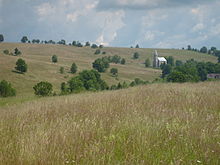Lesica (Miedzylesie)
| Lesica | ||
|---|---|---|
 Help on coat of arms |
|
|
| Basic data | ||
| State : | Poland | |
| Voivodeship : | Lower Silesia | |
| Powiat : | Kłodzko | |
| Gmina : | Międzylesie | |
| Geographic location : | 50 ° 9 ′ N , 16 ° 36 ′ E | |
| Height : | 600 m npm | |
| Residents : | 53 | |
| Postal code : | 57-530 | |
| Telephone code : | (+48) 74 | |
| License plate : | DKL | |
| Economy and Transport | ||
| Next international airport : | Wroclaw | |
Lesica (German Freiwalde ) is a village in the south of the powiat Kłodzki in the Lower Silesian Voivodeship in Poland. It belongs to the municipality of Międzylesie ( Mittelwalde ), from which it is five kilometers to the west.
geography
Lesica lies between the Habelschwerdter Mountains and the Eagle Mountains in the lower Erlitz Valley , which forms the border with the Czech Republic up to this point. Neighboring towns are Różanka ( Rosenthal ) in the northeast, Międzylesie in the east, Kamieńczyk ( Steinbach ) and Czerwony Strumień ( Rothflössel ) in the southeast, the Czech Bartošovice v Orlických horách ( Barzdorf ) in the west and Niemojów ( Marienthal ) in the northwest. The 713 m high Bochniak ( salt dome ) rises to the southeast .
history
Freiwalde was 1570-1578 together with the neighboring villages of Marienthal and Stuhlseiffen on royal property by Leonhard von Veldhammer (also Feldhammer , † 1583), the chief forest master of the County of Glatz , measured and created and was owned by the Bohemian Chamber . It was initially called "Neurosenthal" and belonged to the parish church of Böhmisch Petersdorf . Around 1600 the then Lutheran inhabitants of the village built a wooden church, which was looked after by the Lutheran pastor from the Bohemian Batzdorf ( Bartošovice ) from 1613 to 1624 . It then served as a Catholic church and was dedicated to Ebersdorf as a branch church . After the parish of Rosenthal was established in 1665, it was added there.
Together with other chamber villages in the Habelschwerdt district , Freiwalde was acquired in 1684 by the governor of Glatz, Michael Wenzel von Althann , who formed the lordship of Schnallenstein from the newly acquired villages , whose main town was Rosenthal, so that it was also known as the "lordship of Rosenthal". The Freiwalder Freirichtergut remained independent, but fell under the higher jurisdiction of the Dominium . With the approval of the Prague Consistory , a new stone church was built on the site of the wooden church in 1704, which was consecrated on October 24, 1706 and was still a subsidiary church of Rosenthal.
After the Silesian Wars , Freiwalde and the County of Glatz came to Prussia in 1763 with the Peace of Hubertusburg . In 1787–1797, Baron Michael von Stillfried, the owner of the Schnallenstein / Rosenthal estate at the time, laid out the "Neuwalde Colony" on cleared land north-west of Freiwalde. It consisted of 16 houses and belonged to the Freiwalde community.
After the reorganization of Prussia, Freiwalde belonged to the province of Silesia from 1815 and was initially incorporated into the district of Glatz. In 1818 it was reclassified to the Habelschwerdt district , to which it belonged until 1945. After a cattle epidemic, a Leonhardi pilgrimage was introduced in 1841 . In 1939 398 inhabitants were counted.
As a result of the Second World War , Freiwalde fell to Poland in 1945, like almost all of Silesia, and was renamed Lesica . The German population was expelled. Some of the new residents were displaced from eastern Poland . Due to the remote border location, however, many residents left Lesica in the next few decades, so that the number of inhabitants fell significantly. 1975-1998 Lesica belonged to the Wałbrzych Voivodeship .
Attractions
- The branch church of St. Martin ( Kośćíoł Św. Marcina ) was built by master mason C. Kristen together with the Freiwald stonemasonry. The ceiling painting is from 1789. The side altar painting of St. Leonhard created Hieronymus Richter . On the cemetery gate from 1706 there are sculptures of Saints Barbara and Mary.
- Ruins of the former free straightening shop
- Wayside shrine with St. Trinity
Personalities
- Ernst Route (1820–1885), Catholic clergyman and member of the Reichstag
literature
- Joseph Kögler : The chronicles of the county Glatz . Revised by Dieter Pohl . Vol. 4, ISBN 3-927830-18-6 , pp. 126-129.
- Dehio Handbook of Art Monuments in Poland Silesia , Munich Berlin 2005, ISBN 3-422-03109-X , p. 543.
- Peter Güttler: The Glatzer Land . Verlag Aktion Ost-West eV, ISBN 3-928508-03-2 , p. 35.
Web links
- Historical and current recordings as well as geographical location
- Interior view of the St. Martin branch church
Individual evidence
- ↑ Jaroslav Šůla: Údoli horniho toku Divoké Orlice; in: Orlicke hory a Podorlicko, 2012; see footnote 70 on p. 134 ( Memento of the original dated November 4, 2016 in the Internet Archive ) Info: The archive link was automatically inserted and has not yet been checked. Please check the original and archive link according to the instructions and then remove this notice.


